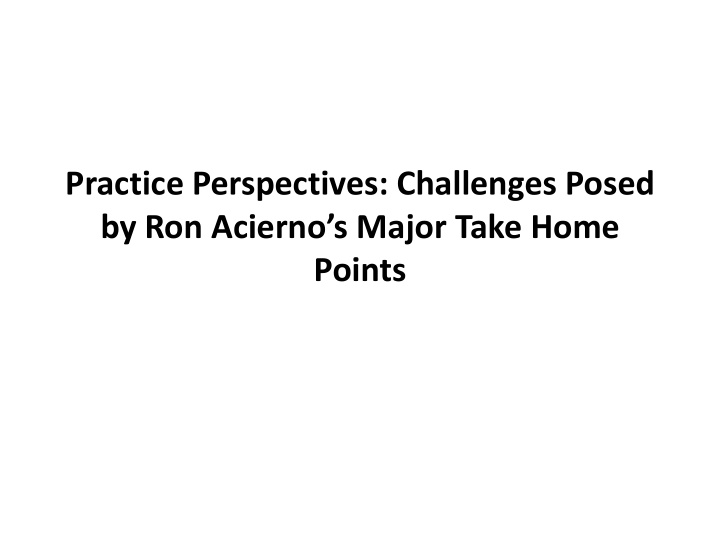



Practice Perspectives: Challenges Posed by Ron Acierno’s Major Take Home Points
Elder mistreatment (including neglect) occurs twice as frequently as previously thought, making it slightly more prevalent than intimate partner violence and twice as common as child mistreatment. However, interventions for addressing elder mistreatment are hampered by: • less heightened public and professional concern • fewer resources • little evidence of program effectiveness
Much elder mistreatment is really spouse abuse. However: • Often Domestic Violence Programs are slow to adapt to the needs of older victims. • The public and many professionals find “caregiver stress and burden” a more compelling focus for intervention than “power and control” in elder mistreatment situations. • Adult Protective Services (the primary response to elder abuse) has different philosophies and approaches than Domestic Violence Programs, which can challenge collaboration.
Social support (including community interventions) helps protect against elder mistreatment. However: • Stagnant or declining public and private funding means cutbacks in senior services, even as the older population grows and its needs increase. • There are current and future shortages of paid caregivers, and there will be fewer family caregivers available for aging baby boomers. • Social connections in the form of close friends, helpful neighbors, and nearby family are shrinking.
In addition: • Emotional mistreatment: Women are typically victimized by family members (41%) and men by non-family members (47%). However, emotional mistreatment in general does not receive the serious attention deserves. • Physical mistreatment: Women are typically abused by their partners (68%) and men by non-family members (45%). However, community interventions aim more at problem response than prevention.
References Slide Two Health Policy Institute of Ohio. (2010). Family violence in Ohio . Columbus, OH: Health Policy Institute of Ohio. Anonymous. (2002). Senator John Breaux: The Elder Justice Proposal of 2002. Journal of Elder Abuse & Neglect, 14 (2/3), 37-85. Ploeg, J., et al. (2009). A systematic review of interventions for elder abuse. Journal of Elder Abuse & Neglect, 21 (3), 187-210. Slide Three US House Select Committee on Aging. (1981). Elder abuse (An examination of a hidden problem) (Committee Publication No. 97- 277). Washington, DC: US Government Printing Office. Slide Four Anetzberger, G. J., & Teaster, P.B. (2010). Future directions for social policy and elder abuse: Through the looking glass of generational characteristics. Journal of Elder Abuse & Neglect , 22 , 207-215. Putnam, R.D. (2000). Bowling alone: The collapse and revival of American community . New York: Simon & Schuster. Slide Five Anetzberger, G.J, Korbin, J.E., & Tomita, S.K. (1996). Defining elder mistreatment in four ethnic groups across two generations. Journal of Cross-Cultural Gerontology, 11, 187-212. Nerenberg, L. (2008). Elder abuse prevention: Emerging trends and promising strategies . New York: Springer Publishing Company.
Recommend
More recommend